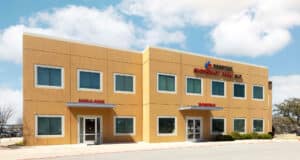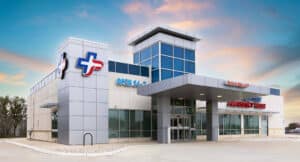When a gallbladder attack strikes, you need help right away. They can be extremely painful and overwhelming, but quick relief is within reach at Prestige ER. Our skilled physicians are ready to provide fast, expert care so you can feel better as soon as possible.
What Is a Gallbladder Attack?
A gallbladder attack (also called biliary colic) occurs when gallstones get stuck while traveling through the tube to the stomach (bile duct), blocking the outflow of bile. This causes the gallbladder to spasm, which can lead to severe pain that can cause nausea, vomiting, fever, and chills.
Gallbladder pain feels like a sharp, gripping, or gnawing pain in the upper right or center of the abdomen. It can sometimes be mistaken for a heart attack, especially when the pain radiates behind the breastbone or in the upper back.
Common Signs and Symptoms of a Gallbladder Attack
Abdominal Pain
Gallbladder pain typically occurs in the upper right abdomen, just below the rib cage. It may radiate to the right shoulder blade and is often accompanied by nausea, vomiting, and increased discomfort after eating fatty foods.
Pain After Eating Fatty Foods
Eating fatty foods may trigger gallbladder pain. This happens because the gallbladder contracts to release bile, a process that can press against gallstones or inflamed tissue, causing discomfort.
Nausea and Vomiting
An inflamed or blocked gallbladder, often due to gallstones, can disrupt the release of bile needed for proper digestion. This bile buildup in the digestive system can trigger the body’s “sick” response, leading to nausea and vomiting.
Indigestion and Bloating
An inflamed to obstructed bladder, often caused by gallstones, can interfere with digestion and trap gas in the stomach. This can lead to painful symptoms like indigestion and bloating.
Fever and Chills
Approximately one-third of people with gallbladder disease or infection experience fever and chills. These symptoms occur as the body’s response to inflammation in the gallbladder, contributing to overall feelings of illness.
Changes in Stool and Urine
A malfunctioning or blocked gallbladder can disrupt the flow of bile to the intestines, resulting in noticeable changes (e.g., lighter-colored stool and darker urine). These changes occur due to elevated bilirubin (a component of bile) levels in the blood.
Jaundice
When the gallbladder is unable to properly release bile due to inflammation or blockage, it can lead to an accumulation of bilirubin (a yellow pigment in bile) in the body. This excess bilirubin leads to jaundice, characterized by a yellowing of the skin and eyes.
Persistent or Recurrent Episodes
If you experience a gallbladder attack, there’s a 70% chance of having another, especially if gallstones are present. Gallstones can cause repeated blockages, leading to persistent pain or recurrent attacks.
Weird Signs of a Bad Gallbladder
Here are some unusual signs that your gallbladder may be acting up or not functioning properly. Recognizing these signs can help you determine if your gallbladder is bad, inflamed, or infected:
- Pain behind the breastbone.
- Pain in the right shoulder blade.
- Heartburn, chest pain, or ingestion.
- Rapid weight loss.
- Skin itching.
- Dark urine.
- Pale-colored stools.
What Causes a Gallbladder Attack?
- A buildup of fatty substances in bile (e.g., cholesterol).
- Rapid weight loss or gain, increasing the risk of gallstones and, therefore, attacks.
- Hormonal imbalances.
- Being of Native American descent.
- A family history of gallstones.
When to See a Doctor
Seek immediate medical care if you experience sudden or severe abdominal pain or pain that persists for several hours. This is especially important if the pain is accompanied by nausea, vomiting, fever, or jaundice.
Complications of Untreated Gallbladder Problems
Untreated signs of gallbladder issues, often related to gallstones, can lead to serious and potentially life-threatening medical emergencies, including:
- Gallbladder inflammation (cholecystitis).
- Infection within the gallbladder.
- Tissue death in the gallbladder (gangrene).
- Gallbladder rupture (perforation).
- Bile duct blockage and jaundice.
- Pancreatitis (inflammation of the pancreas).
- Gallbladder cancer.
How Can Gallbladder Problems Be Prevented?
Here are a few ways you can help prevent gallbladder problems:
- Maintain a healthy weight and body mass index (BMI).
- Eat a balanced diet rich in fiber and healthy fats.
- Avoid excessive saturated fats and cholesterol.
- Exercise regularly.
How Can Prestige ER Help You With a Gallbladder Attack?
If you or a loved one experiences a gallbladder attack, go to your nearest Prestige ER for immediate emergency room services and pain relief. Our board-certified physicians can provide medication, IV therapy, and, if necessary, perform emergency surgery to remove your gallbladder, addressing the underlying cause of the attack.
Prestige ER is available 24 hours a day, 365 days a year, for patients throughout the San Antonio, TX, area.












